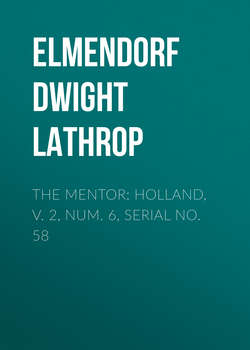Читать книгу The Mentor: Holland, v. 2, Num. 6, Serial No. 58 - Elmendorf Dwight Lathrop - Страница 1
The History of Holland
ОглавлениеONE
The history of Holland is a record of the unexpected. One might think that this flat country would have a story as monotonous as the land on which it is built, that it would be the last part of the world to be the center of fierce battles and bloody wars. Yet there took place in this little country, formed principally of the mud deposited by three rivers, the Rhine, the Meuse, and the Schelde, some of the most important deeds in the history of the world.
The earliest inhabitants of this part of Europe are said to have been some of the barbarians that accompanied the Cimbri and Teutons in their expedition against Italy. The Romans, however, held sway over this district until near the end of the fourth century, when the Franks took possession and settled there. Later the Holy Roman Emperor Charlemagne extended his supremacy over the whole of the Netherlands, and under his successors a system of dividing the land among the vassal princes gradually developed. Thus the feudal system grew up.
The situation of the country on the ocean and the mouths of three great rivers invited the people to commerce. Then, also, the big cities grew up and surrounded themselves with strong forts.
In 1477 the Netherlands came into possession of the House of Hapsburg by the marriage of Mary of Burgundy, the daughter of Charles the Bold, with Maximilian, afterward emperor of the Holy Roman Empire. Their son, Philip the Handsome, was the father of Charles V, who subsequently became King of Spain. Under his rule the Netherlands enjoyed a golden era of prosperity; but during the reign of his bigoted son, Philip II, there began that apparently hopeless struggle of the weak people of the north against the haughty Spaniards, which lasted for eighty years and which ended in the establishment of the powerful Dutch republic. The great founder of Dutch liberty was William of Nassau, the Silent. Today he is revered by the Dutch as a mighty hero and martyr.
It was in 1579 that the Union of Utrecht laid the foundation on which the republic of the United Netherlands was to be raised. By the Peace of Westphalia in 1648 the independence of the United Provinces was recognized.
The prosperity of Holland was great. Its navigators explored the most distant coasts in the world, and its trading posts in East India yielded a rich harvest. It had commerce with all nations, and at the same time its art reached its highest point of excellence.
For many years the fortunes of the Netherlands varied from good to bad. In 1795 the French Republicans took possession of the country and founded the Batavian republic. In 1806 Louis Bonaparte was created king of Holland by his brother Napoleon. Four years later Napoleon annexed Holland to France, giving as the reason his belief that it was formed of the alluvial deposit of French rivers. At last, in November, 1813, the French were expelled from Holland; and in 1815, by the Congress of Vienna, the southern or Belgian province of the Netherlands was united with the northern into a single kingdom, and the Prince of Orange was created king of the Netherlands under the title of William I. This union was severed by the Belgian revolution of 1830. Ten years later, William I abdicated in favor of his son William II, who was in turn succeeded by William III.
His daughter Wilhelmina is the present ruler of Holland. Her daughter, Princess Juliana, was born April 30, 1909.
